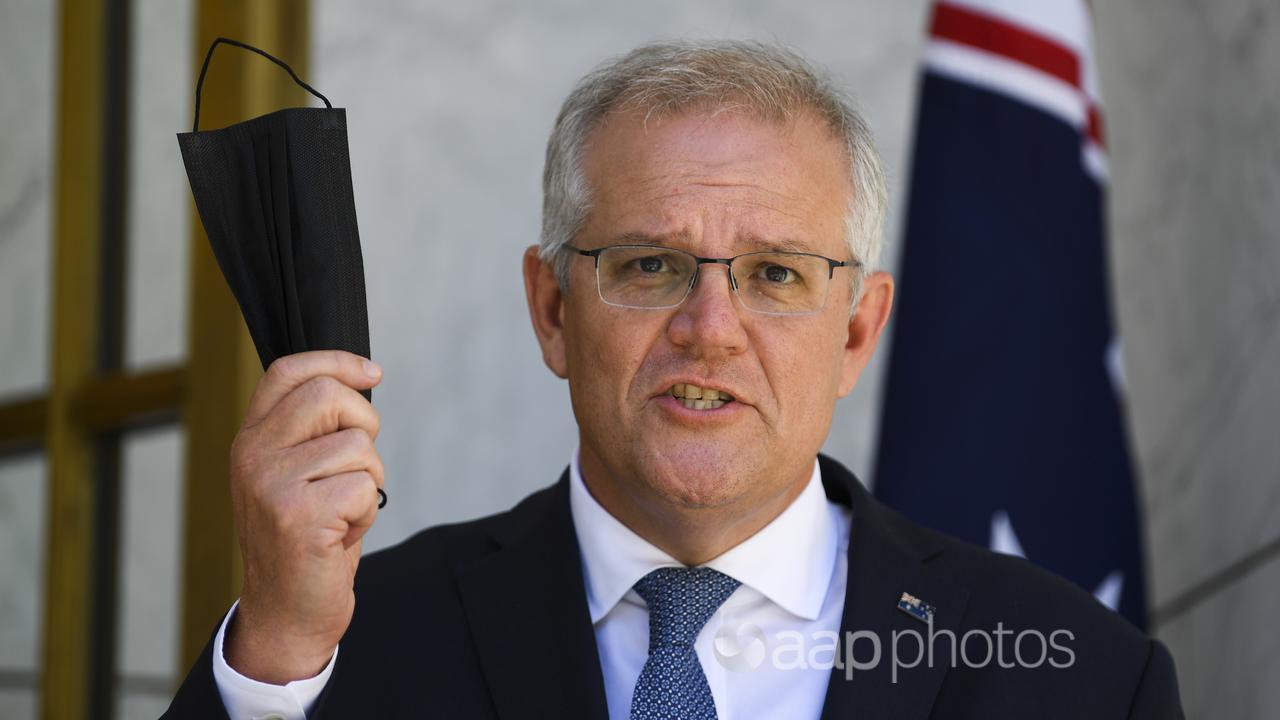Prime Minister Scott Morrison has put his handling of COVID-19 at the centre of his re-election campaign with a claim that 40,000 Australians are alive thanks to the federal government’s management of the pandemic.
The claim is misleading, with experts telling AAP FactCheck the prime minister is wrong to take full credit for Australia’s relatively low COVID-19 death rate to date. They also said drawing direct comparisons between countries in order to calculate the number of lives ‘saved’ is difficult due to the various demographic, geographical and economic differences across the globe.
During a February 4 press conference, Mr Morrison said the actions his government took “saved businesses from bankruptcy, it saved Australians from losing their jobs, from losing their homes. It saved 40,000 lives.”
The prime minister made similar references to saving 40,000 lives on at least 25 separate occasions in the four months prior to April 9, according to transcripts published on the prime minister’s website (see examples here, here, here, here, here and here).
Mr Morrison repeated the claim in a campaign video posted to YouTube on April 9, one day before he called an election for May 21 (video mark 31sec). In the video, he says: “40,000 people are alive in Australia today because of the way we managed the pandemic.”
In a virtual address to the AFR Business Summit on March 8, 2022, the prime minister said the figure was based on comparing Australia’s COVID-19 death rate to the average death rate across all 38 OECD countries.
According to data from the John Hopkins Coronavirus Resource Center, Australia had recorded 6562 COVID-19 deaths to April 11, 2022, a rate of 25.9 deaths per 100,000 people.
In comparison, the rate across all 38 OECD countries was 195 COVID-19 deaths per 100,000 people, according to AAP FactCheck calculations using the same data. If the same rate was applied to Australia’s COVID-19 toll, 49,405 deaths had occurred in the country.
On that basis, the suggestion Australia would have faced around 40,000 more COVID-19 deaths if they had occurred in keeping with the OECD average is broadly correct.
However, within the OECD there have been a broad range of pandemic outcomes to date. Per-capita death rates range from 300.2 per 100,000 in the US to just 9.3 deaths per 100,000 in New Zealand, according to the John Hopkins data. The same rates applied to Australia would put the country’s COVID-19 deaths at 76,058 and 2356 respectively.
AAP FactCheck asked four experts about the utility of comparing Australia’s COVID-19 death rate against the OECD average, and who should take the credit for keeping Australian deaths relatively low.
Chris Baker, a biosecurity statistician at the University of Melbourne, told AAP FactCheck in an email that benchmarking Australia’s COVID-19 deaths against the OECD average is “a reasonable broad-brush comparison”.
However, because COVID severity increases greatly with age, a fair comparison should also account for age differences between populations, he said.
Dr Baker also said Australia’s low death rate was due to policy implemented at multiple levels of government.
“The international borders are the realm of the federal government, while control of outbreaks through lockdowns were implemented through state government powers. It is the synergy of these policies that led us to a low COVID death rate,” he said.
Associate professor Linda Selvey, an epidemiologist from the University of Queensland, told AAP FactCheck that Australia “has one of the best healthcare systems in the world and a relatively young population compared to many OECD countries“, meaning Australians are generally at lower risk of developing severe cases than other populations.
Dr Selvey said Australia also benefited from its remote location, which allowed the government to close international borders more effectively than many other countries.
“This means that once we controlled our first wave, with lockdowns and other measures, we were largely able to keep COVID out for much of 2020. This bought us time and also reduced the number of cases,” she said.
“Even if you could attribute border closures to the federal government alone – noting that state and territory governments may have had input into this decision, the other factors – healthcare, age and overall health status – are not attributable to the federal government.”
Associate professor Fiona Stanaway, an epidemiologist at the University of Sydney and the co-author of a 2020 journal article about Australia’s COVID-19 death rate, told AAP FactCheck that other variables such as climate, the number of hospital beds, hospital staff ratios and population densities may have impacted the spread of COVID-19 in Australia.
“You think of places like Queensland where people are much more spread out in the city. They’ve got a big house and a yard, as opposed to cities where people are living very densely in apartments and crowding onto public transport. That sort of stuff makes a difference to transmission,” Dr Stanaway said in a phone interview.
She said some federal government interventions such as the border closure helped slow the spread of the virus. However, various other factors also contributed to Australia’s low death rate and “we can’t say it’s all due to the federal government”.
Nobel Prize-winning immunologist Peter Doherty told AAP FactCheck the federal government could legitimately take some credit for stemming the COVID-19 tide but other Australians also contributed to the low death rate.
“We had a very good PCR test early on. That was down to our people at the Doherty Institute because they isolated the virus and got a PCR test going before the end of January (2020),” Prof Doherty said in a telephone interview.
Prof Doherty said Indigenous communities also deserve “tremendous credit” for keeping the virus away from vulnerable populations and potentially saving many lives.
“I think he (Scott Morrison) has got every right to say (40,000 lives were saved), but he doesn’t have every right to take all the credit by any means,” Prof Doherty said.
The Verdict
The prime minister’s claim that his government’s handling of the pandemic saved 40,000 lives is misleading.
While experts said federal policies, such as swiftly closing the borders, had contributed to Australia’s low COVID-19 death rate to date, there were various other factors involved, such as the country’s relatively young population, isolation, climate and the action of state governments. These factors meant drawing direct comparisons to other countries or assigning credit to the federal government for lives saved was flawed.
Misleading – The claim is accurate in parts but information has also been presented incorrectly, out of context or omitted.
* AAP FactCheck is an accredited member of the International Fact-Checking Network. To keep up with our latest fact checks, follow us on Facebook, Twitter and Instagram.
All information, text and images included on the AAP Websites is for personal use only and may not be re-written, copied, re-sold or re-distributed, framed, linked, shared onto social media or otherwise used whether for compensation of any kind or not, unless you have the prior written permission of AAP. For more information, please refer to our standard terms and conditions.


















